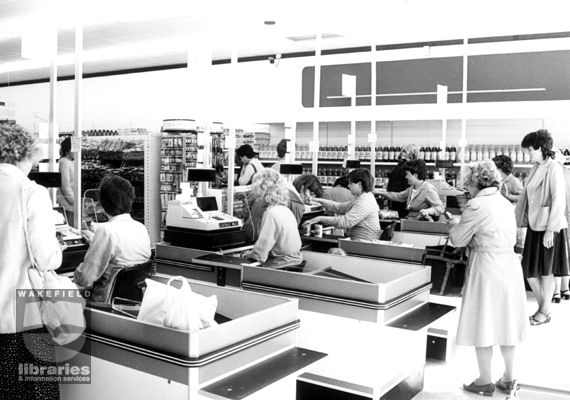Retail and Community: Strikes and Lockouts
On 9 May 2019, scholars from around the country gathered at the University of Wolverhampton for a Centre for the History of Retailing and Distribution seminar on Retailing and Community: the Social Dimensions of Commerce in Historical Perspective. The range of papers demonstrated how fruitful thinking about retail and community can be. Some papers were discussing forms of retailing that had an explicit social purpose: charity shops, community shops and co-ops, while others examined social elements of commercial retailing.
Retailing in coalfield communities was a recurring theme throughout the day. Ian Mitchell’s work on co-ops included examples from Chesterfield and other coal mining towns. Pierre Botcherby explored connections between community organising in opposition to retail regeneration projects in St Helens in the context of previous organising against pit closures.
Grace Millar represented our project with a paper that brought together her PhD research on the 1951 New Zealand Waterfront Dispute with research from this project: “‘The grocer carried me for three months’: Understanding shop credit during extended strikes and lockouts”. The paper discussed credit, and other forms of support, from grocers and other retailers during strikes and lockouts. Such credit was rarely new, but based on an existing practice of grocers credit that was central to working-class communities’ food shopping, before the rise of supermarkets.
Oral history interviews for this project have suggested that retailers support during strikes and lockouts could be a fruitful source of further information about shopping in working-class communities. By the mid-1980s, working-class food shopping had changed significantly; there were more supermarkets and fewer corner shops. The 1984/5 strike took place just as Tesco’s and Sainsbury’s rising market share over took the Co-Op and independent stores' falling market share.

G T Smith's supermarket in the 1980s (Wakefield Express, digitised by Wakefield Library)
Despite these changes, interviewees have told us about support they received from supermarkets. Tony Twibey described the actions of the supermarket chain he shopped at:
“G T Smiths in Knottingley were a big supermarket in them days. And they gave us a ten pound voucher four times in the strike and gave us a Christmas Hamper - yeah. They were really good to miners were G T Smiths.
But it was smack in the middle of Pontefract, Castleford and Kellingley where the mines were. But they knew who their customers were, but they didn’t have to do that. They were really good to us.”
Vouchers, like credit, were part of normal practice that were used differently in extraordinary circumstances. There is even evidence of larger chains supporting strike centres; John Walton on Morrisons: “In fact Morrisons in Staveley - the Miners’ Welfare and that’s still open – just round the corner was a Morrisons supermarket and the manager there was very good and he used to supply strike centre with food.”
Working-class shopping patterns had changed significantly by the mid-1980s, but the places where working-class people shopped continued to use existing practices to support their customers during a long strike. Strikes and lockouts can be a really good way of accessing aspects of working class life that are not normally recorded. Every day food shopping is not easy to research. Strikes and lockouts are extraordinary events – but they’re extraordinary in a way that can be used by historians to understand aspects of every day life. The 1984/5 strike can tell us about continuity and transition as retailing changed.
The most obvious starting points to understand retail support during industrial disputes is to look at existing ways of understanding both retail actions and supporting during industrial disputes. That is to look at retail support in terms of loyalty or solidarity.
Shops in working-class area had good reasons to offer credit, which can promote loyalty. Oral history interviews suggest that families valued credit given during industrial disputes for decades. Sue Bruley’s work on the 1926 Miners’ Lockout includes a woman’s account of her mother walking an extra mile to shop two decades after the dispute was ended, because of the credit she’d received (p.75). Such a story is not rare.
Solidarity is usually the starting point for understanding contributions to strike funds or families on strike. Diarmaid Kelliher has done really interesting work on the geographies of solidarity during the 1984/5 strike (and a collection on the subject that he edited with David Featherstone is available on-line). Considering material about retail support during a strike it’s easy to ask: was this an example of solidarity or were shopkeepers acting in their economic interest?
The goal of the paper was to look beyond these binary options and use this example to understand the complexity of the economic and social aspects of retailing relationships. Rather than seeing economic and social motivations as two different options – these examples show how they were intertwined.
The final point in the paper was that the interview clips showed an understanding of the complexities of retail relationships. Interviewees acknowledge the importance of mining customers to retailers. They remember and value the support they received, but they don’t lose sight of the importance of themselves as customers. One of the values of oral history is that working-class people can articulate the complexities of their experiences.
In this project, we want to look at mining communities as a whole, including those who worked in and ran shops. We have done some interviews that touch on this subjject – but we are interested in hearing more from people who were involved in retail in mining communities – particularly food shops and pubs.
For more information please contact the Corporate Communications Team.


/prod01/wlvacuk/media/departments/digital-content-and-communications/submitted-news-images/Smelting-knife.png)
/prod01/wlvacuk/media/departments/digital-content-and-communications/images-2024/250630-SciFest-1-group-photo-resized-800x450.png)
/prod01/wlvacuk/media/departments/digital-content-and-communications/images/stock-images/WLV-email-header-banner---City-courtyard---Opportunity-teaser.png)
/prod01/wlvacuk/media/departments/digital-content-and-communications/images-2024/Arthi-Arunasalam-teaser.jpg)
/prod01/wlvacuk/media/departments/digital-content-and-communications/web-images-and-banners/Birmingham-City-womens-U21-squad.jpeg)
/prod01/wlvacuk/media/departments/digital-content-and-communications/submitted-news-images/Business-School-800x450.jpg)
/prod01/wlvacuk/media/departments/digital-content-and-communications/images-2024/240920-Forensic-Science-Resized.jpg)